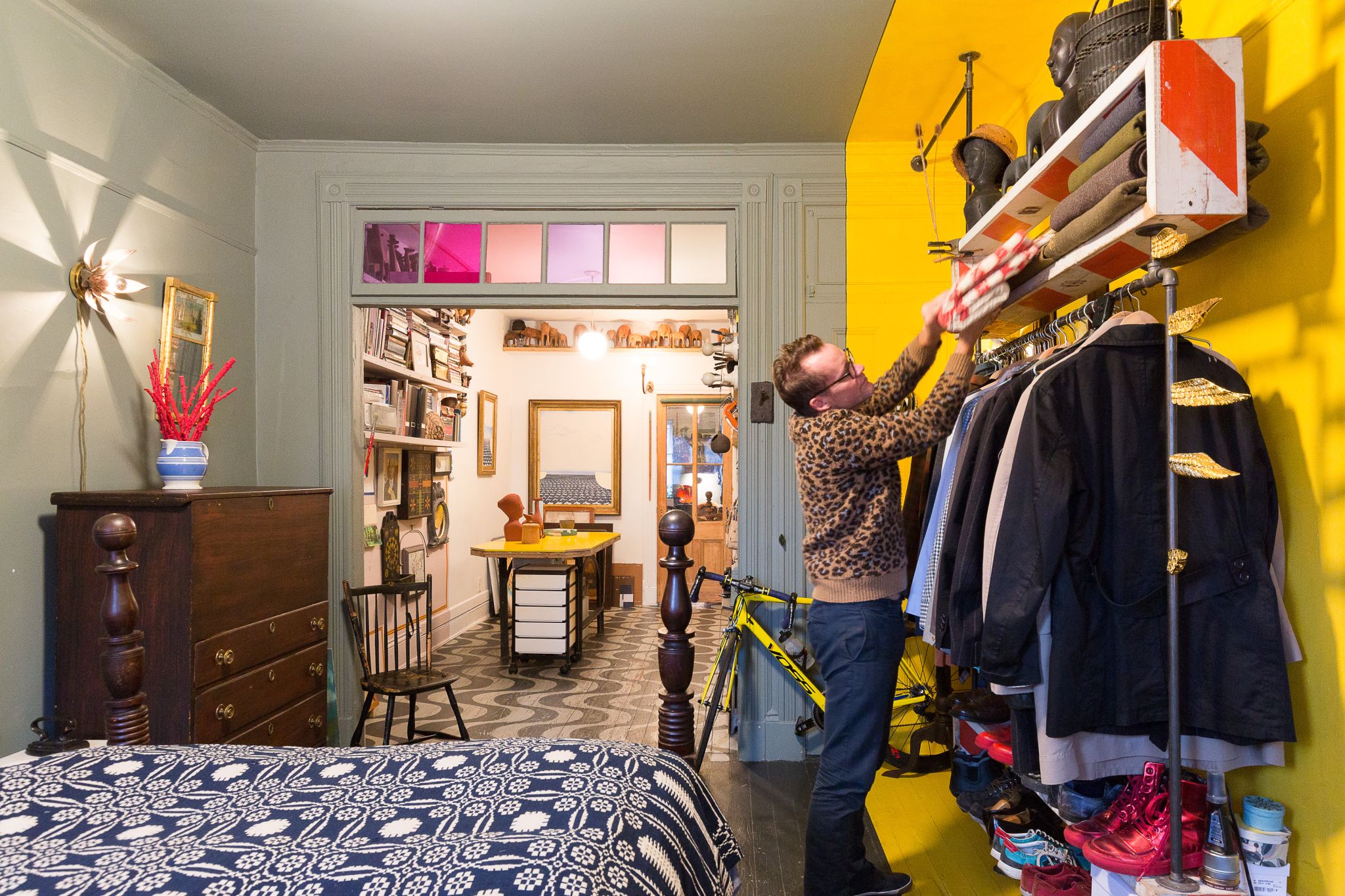Sweaters in the oven. Shoes in the kitchen cabinets. Books in the freezer. New Yorkers pay a median $3,400 a month for their tiny apartments, so they've learned to get mighty creative when it comes to maxing out every square foot.
Although your house may be much roomier than the typical NYC studio (thank God), you can banish clutter once and for all by pledging allegiance to these six savvy strategies.
#1 When You Buy Something, Toss Out Something
You don't have to organize the things you don't have.
"I've reached my saturation point with stuff, so I developed a new formula," says Matt Austin, an artist and designer living in a 700-square-foot railroad flat in Bushwick, Brooklyn. First, if he hasn't worn something in two years, it goes. Then, if anything new comes into his life, something else has to go out. "Ideally, two things," he says.

In addition to ruthlessly pruning your belongings, keeping an eye on how much to buy in the first place makes an even bigger difference.
Adopt a capsule wardrobe -- a minimal collection of clothes that mix, match, and layer for multiple uses. It frees up closet space considerably.
Ask yourself a few questions before hitting the "Add to Cart" button on Amazon. Does it really make sense to order that quesadilla maker when you can already make quesadillas in your microwave, on your stovetop, and in your oven?
Related: Why Organizing and Decluttering Save You Money
#2 Think Vertically
Walls can do a lot more than hold the ceiling up.
"People look at space in terms of square footage instead of cubic footage," says Ann Sullivan, owner of New York City-based Organizing People for Life. "Lie on the floor and look up."
Sullivan suggests hanging bicycles from the ceiling and installing shelves high up along the perimeter of a room. In the kitchen, free up drawer and counter space by hanging pegboards for utensils and magnetic strips for knives.
#3 Add Storage to Your Doors
Use the inside of every closet, cabinet, and interior door of your home. Sullivan mounts magazine file boxes to the inside of kitchen cupboards to store tinfoil and plastic wrap. In her Manhattan two-bedroom, Organize Me Inc. owner Janine Sarna-Jones uses a Container Store system that allows baskets of varying sizes to attach to the back of the closet door for vertical storage tucked neatly into existing closet space.
A few more door ideas:
- Mount your hairdryer to the inside of your sink cabinet.
- Use shoe bags to store miscellaneous items like cleaning supplies, light bulbs, and batteries in your hallway closet.
- Mount a horizontal towel bar on a closet door and hang boots, sneakers, scarves, or ties from it.
- Store a whole drawer-worth of bras in one vertical cascade of connected hangers mounted behind your closet door.
#4 Containerize Everything
Ilana Eck, a New York lawyer by day and founder of the entertaining and lifestyle blog "Stylish Spoon," admits to holding on to a lot of belongings. The only way it works is by containerizing her life.

For her, organizing is all about storing her containers exactly where her family members will be when they're in need of the contents. Toys are in inexpensive fabric storage boxes in her children's closet.

The front hall closet hosts containers for her husband's cycling gear.

Don't forget your furniture can double as containers, says Sullivan, like ottomans with interior storage, or a coffee table with drawers.
If you're using containers in a visible spot, “that can be part of your aesthetic," says Sullivan. “But you have to be on top of how you're displaying things." Uniform containers are easier on the eye, and clear boxes are best hidden in closets.

#5 Curate Your Stuff Into 'Art'
You can double your storage space by unabashedly keeping certain items out in the open instead of squirreling them away. For example, Sullivan suggests hanging pots and pans above a kitchen door if possible. What could be more appropriate kitchen decor than cookware?
Related: How Professional Chefs Set Up Their Kitchens
Austin swears by what he calls the “anti-closet" -- just a clothing rack out in the open. Doing so forces him to cut back on his possessions and keep them organized, since everything is visible. “The whole thing is really an exercise in artistic living through good design," he says.

You can also consider which items you already own that can do double duty as fun design and storage. Clear out a spot on your bookshelf by using a stack of hardcover books as a quirky lamp stand. Or remove the pages from one of those books and wrap it around your wireless router or modem to eliminate the need to store these ugly necessities out of sight.
#6 Use All Your Nooks and Crannies to Hide Clutter
In spy movies, someone is always pulling valuables from secret hiding spots. You may not be a spy, but your home has lots of nooks and crannies that can become hidden storage, just like in the movies. Consider installing drawers behind stair risers or in the dead space under your cabinets. If there are a few inches between your refrigerator and the wall, build a roll-out pantry for storage.
Hide things in plain sight. Cut out the wallboard between the studs to create space to fit narrow shelves for small items. Then, cover the storage space with an easily removable painting or print. Or go the extra step and hinge the art to make a door. James Bond would be proud!
